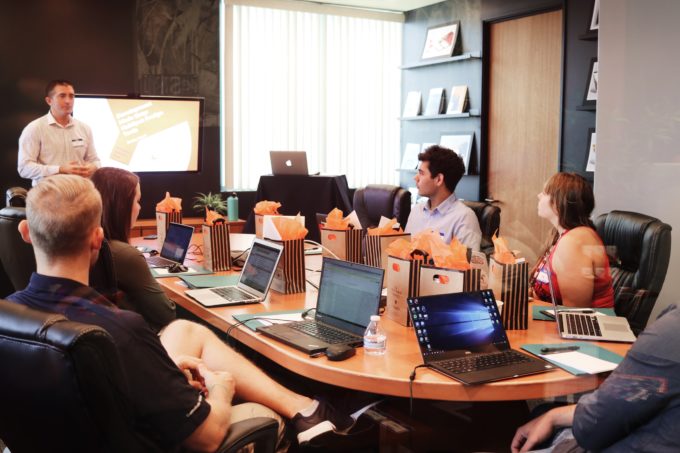
Stress busters: How to help employees help themselves
Dr. Rachel Lewis explores how empowering teams to co-create solutions can reduce workplace stress and boost wellbeing...

by Jennifer Jordan, Michael D. Watkins, Robert Hooijberg, Silke Mischke Published January 21, 2022 in Human Resources • 7 min read
It has been nearly two years since the first wave of COVID-19 forced organizations worldwide to rethink working practices and shift rapidly to homeworking. Yet as Omicron fears halt the reopening of offices, even among firms that make a virtue of in-person interactions, there is a lively debate over the future of the workplace.
Many leaders remain resistant to remote work for reasons ranging from lack of trust that employees will be productive to the risk of deteriorating culture. For example, last summer, several major financial institutions, including Goldman Sachs and JPMorgan, asked most workers to return to the office, reflecting legitimate concerns that working from home could limit opportunities for spontaneous learning and creativity.
But forcing everyone to come back to the office full-time is neither desirable nor smart. At a time when employees are leaving their jobs in record numbers, clever employers will recognize the need to offer flexible work options to retain key staff. Many employees are indeed rethinking their priorities after COVID and want a better work-life balance.
The result is a growing tension between employee needs and business imperatives. This is particularly the case for organizations focusing primarily on capturing efficiency gains by reducing office space. This approach is at odds with the growing realization that certain types of impact are limited in virtual environments. It’s increasingly evident that collaboration, innovation, acculturation and dedication are unlikely to be achieved or sustained virtually.

Forward-thinking organizations have worked out what aspects of work warrant in-person interactions (such as purposeful focus, interpersonal bonding, deep learning, unencumbered experimentation and structured serendipity) and how to make the most of these precious moments. So the right working model will blend the efficiency of remote work and the benefits of bringing people together. Success in doing so will satisfy employees’ desire for flexibility and an improved work-life balance while maximizing workforce productivity.
Yet, although most organizations see “hybrid” models as the inevitable compromise, there is still no consensus among leaders on the best way to make this work in practice —particularly when it comes to collaboration across a varied spectrum of hybrid models. Further considerations include: is it possible to create an inclusive culture when working from home? And, with burnout on the rise, how should work force policies adapt to ensure that everyone feels supported?
Companies that mandate office returns risk an exodus of staff in a tighter labor market. But although employees want flexibility in where they work, this brings with it the risk of team fragmentation and incoherent and suboptimal cross-functional collaboration, as employees set their own schedules.
Organizations cannot allow employees to work anywhere and in any way; they need to issue clear guidance. Working patterns will ultimately be determined by a complex mixture of the role, the home environment, and the variation of work demands.
What is essential is unity and frequency of interaction. If physical work spaces become destinations for collaboration, innovation, dedication and acculturation, rather than individual work, then teams will need to synchronize schedules. If, for example, the policy is three days a week in the office, team members will need to be physically present on the same days. The degree of flexibility should be driven by the needs of teams and not individuals.
It will be impossible to coordinate or standardize workflow through centralized control. Why? Because teams vary widely in terms of the extent they need to collaborate and innovate. There is no “one best way”. Individual team leaders, therefore, need to be given the power to make these calls.
That said, organizations need to put guardrails in place to hedge against the risk of cultural disintegration — say a company-wide policy to work a minimum of 50% of the time in the office — but individual work groups must be given the flexibility to set their own terms and, when appropriate, get exemptions to allow some employees to spend more time working remotely.
In order to realize the benefits of this model, there must be high level of reciprocal trust between workers and senior management. One way is to ensure that policies are being applied equitably across workgroups through monitoring and auditing.

“Organizations cannot allow employees to work anywhere and in any way; they need to issue clear guidance. Working patterns will ultimately be determined by a complex mixture of the role, the home environment, and the variation of work demands”
In the new normal, leaders must ensure that equity and inclusion are real priorities. This is not just a hypothetical concern; in one study, workers were randomly assigned to work mostly from home or mostly in the office. After two years, those in the at-home group had a 50% lesser incidence of promotion compared to those who worked primarily in-office. Another study found that home and office workers were promoted at the same rates, but remote workers experienced lower salary growth than their office counterparts.
This suggests that if employees are given the choice to work from home or the office, it is likely that, over time, there will be disparities in both representation in leadership ranks and compensation. Before the pandemic, workers who requested flexibility were routinely stigmatized, as their leaders were mainly in the office. Managers will need to track how working remotely correlates with promotion and pay increases and factor diversity and inclusion into their hybrid models.
If left to individual preferences, there is a high likelihood that the choice to work from home is a function of the employee’s demographics. Many working parents, for instance, have enjoyed the newfound flexibility to fit childcare around work commitments. And for some people with disabilities or chronic health conditions, the option to work remotely has been desired for years. Minority staff want to spend more time working remotely, freeing them from “microaggressions” and enabling them to be their authentic selves.
On the other hand, many younger employees find working from home isolating, and organizations of ten find it difficult to onboard new colleagues in a remote setting. This suggests that employers who want to build diverse and equitable workforces should be cautious about forcing people back to the office full-time. Leaders must also ensure that equal opportunities are upheld across demographic groups.
If office time is reserved for more teamwork, then the design of physical office space will have to change. In the past, some companies created “open-plan offices” to enable people todo their individual work, and meeting rooms for collaboration.
This model will likely be reversed to facilitate hybrid working, with more open spaces for collaboration and private rooms for individual work. Collaboration will demand flexible arrangements, whiteboards, and other collaboration tools as well as enhanced videoconferencing equipment, especially for “multi-modal” meetings, when some are at home and others in the office.
If hybrid work is the future, companies must establish the right workforce policies to ensure that everyone feels supported. Many remote workers struggle with fatigue under heavy workloads, find they can not switch off at home, and face uncertainty over their job or performance.
While a perk for some people, remote work is a burden for many others. Two-thirds of employees have reported experiencing burnout symptoms while working remotely, with employees bound to endless Zoom calls and work emails.
More generally, the pandemic has underscored the need for good employee wellbeing policies. Some remote workers feel isolated and excluded, which can breed feelings of disconnection, erode engagement and corrode culture. Others have thrived away from the distractions of open-plan offices, politicking, and micromanagement.
In response to these developments, many companies have hosted talks from wellbeing experts, conducted group meditation and mindfulness sessions, and provided resilience coaching and virtual meetups. Managers must be trained to tune into the energy level of their teams, and respond to those needs to boost wellbeing levels in the workforce.
Managers also need to encourage employees to recharge and lead by example in doing so themselves. This might include taking entire days off, having meeting-free days, or facilitating regular breaks to encourage staff to leave their homes and exercise in the daylight.
Finding the best way of working will take a great deal of experimentation. The right answers will vary depending on the specific context of each business unit and function. Organizations should monitor the impact of their policies through regular employee surveys and assessments of workloads to understand whether the implemented hybrid model is delivering productivity, wellbeing, and inclusion.
Those leaders who succeed in establishing this sort of balanced and fair working pattern are likely to discover how beneficial an engaged, empowered, and fulfilled workforce can be as they emerge from the COVID crisis.

Social psychologist and Professor of Leadership and Organizational Behaviour at IMD
Jennifer Jordan is a social psychologist and Professor of Leadership and Organizational Behavior at IMD. Jennifer’s teaching, research, and consulting focus on the areas of digital leadership, ethics, influence, and power. She has received specialized training and certifications in lie and truthfulness detection, as well as in conflict resolution within organizations. She is Program Director of the Women on Boards and the Leadership Essentials program, and co-Director of the Leading Digital Execution program.

Professor of Leadership and Organizational Change at IMD
Michael D Watkins is Professor of Leadership and Organizational Change at IMD, and author of The First 90 Days, Master Your Next Move, Predictable Surprises, and 12 other books on leadership and negotiation. His book, The Six Disciplines of Strategic Thinking, explores how executives can learn to think strategically and lead their organizations into the future. A Thinkers 50-ranked management influencer and recognized expert in his field, his work features in HBR Guides and HBR’s 10 Must Reads on leadership, teams, strategic initiatives, and new managers. Over the past 20 years, he has used his First 90 Days® methodology to help leaders make successful transitions, both in his teaching at IMD, INSEAD, and Harvard Business School, where he gained his PhD in decision sciences, as well as through his private consultancy practice Genesis Advisers. At IMD, he directs the First 90 Days open program for leaders taking on challenging new roles and co-directs the Transition to Business Leadership (TBL) executive program for future enterprise leaders, as well as the Program for Executive Development.

Professor of Organizational Behaviour at IMD
Robert Hooijberg is Professor of Organizational Behavior at IMD. His areas of special interest are leadership, negotiations, team building, digital transformation, and organizational culture. Before joining IMD in September 2000, Professor Hooijberg taught at Rutgers University in their MBA and Executive MBA programs in New Jersey, Singapore, and Beijing. He is Program Director of the Breakthrough Program for Senior Executives and the Negotiating for Value Creation course.

Senior Leadership Advisor and Lecturer, IMD and EPFL
Silke Mischke is a Senior Leadership Advisor and Leadership Lecturer at IMD and EPFL, where she teaches leadership in the E4S Master in Sustainability Management, a joint program by IMD, EPFL, and UNIL. She holds a Doctorate in Business Administration and a Master’s degree in Cognitive Psychology. Her work focuses on leadership through the lens of emotional intelligence, exploring its impact on individuals, teams, and organizational performance. She coaches and teaches leaders and teams from a wide range of international organizations, supporting their development through both individual and collective learning. At IMD, she also serves as Co-Director of the Executive Coaching Certificate program.

June 23, 2025 • by Rachel Lewis in Human Resources
Dr. Rachel Lewis explores how empowering teams to co-create solutions can reduce workplace stress and boost wellbeing...

May 13, 2025 • by Luca Condosta in Human Resources
The CDO, formerly a figurehead for regulatory compliance, is now a key driver of company strategy. Luca Condosta describes the essential skills that CDOs require to turn DE&I concepts into actual commercial...

April 30, 2025 • by Manju Ahuja in Human Resources
The pandemic sparked a shift to remote work that’s proving hard to reverse. According to Prof. Manju Ahuja, hybrid models are the new norm—driven by employee expectations, technological advances, and a changing...

April 29, 2025 • by Michael D. Watkins in Human Resources
Use this diagnostic tool and roadmap to rebuild trust and confidence within dysfunctional teams – the first crucial steps toward a future of high performance....
 Audio available
Audio availableExplore first person business intelligence from top minds curated for a global executive audience